BE Semiconductor Industries Bundle
Can BE Semiconductor Continue Its Ascent in the Semiconductor Industry?
The BE Semiconductor Industries SWOT Analysis reveals a company at the forefront of the digital revolution, but what fuels its continued success? This exploration dives into the dynamic world of the Semiconductor Industry, examining how BE Semiconductor (Besi) has not only survived but thrived. We'll uncover the strategic initiatives driving its growth and the crucial role of advanced packaging solutions in its future.
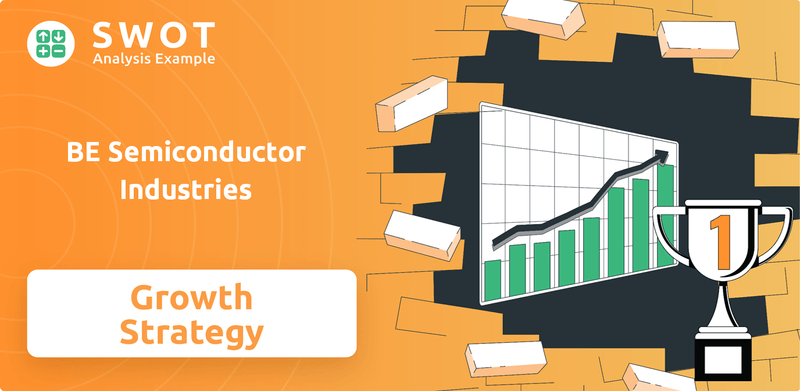
From its inception in the Netherlands, BE Semiconductor has consistently adapted to the ever-changing demands of the market. Today, as a leading Semiconductor Company, Besi's strategic focus on innovation and customer-centricity has positioned it for significant expansion. This analysis provides a comprehensive market analysis of its future prospects, including its expansion plans, technological advancements, and the challenges and opportunities that lie ahead, offering insights into BE Semiconductor's revenue growth and investment opportunities.
How Is BE Semiconductor Industries Expanding Its Reach?
The expansion initiatives of BE Semiconductor Industries (Besi) are strategically aligned with the evolving demands of the semiconductor industry, particularly in advanced packaging. Besi focuses on growth through its leadership in hybrid bonding and advanced packaging technologies. These technologies are crucial for high-performance computing, AI, and automotive applications, enabling Besi to access new customer segments and diversify its revenue streams.
Besi's strategic emphasis on hybrid bonding solutions is critical for the next generation of semiconductors, facilitating higher integration and improved performance. The company's geographic expansion is closely linked to the global semiconductor manufacturing landscape. Besi operates in key regions, including Europe, Asia, and North America, positioning itself to serve major semiconductor manufacturers directly. The company’s presence in Asia, especially in markets with significant foundry and outsourced semiconductor assembly and test (OSAT) operations, is crucial for its continued growth.
Besi is also focused on expanding its product portfolio to support emerging technologies, including developing new equipment for chip-to-wafer and die-to-wafer hybrid bonding. This is becoming standard for advanced packaging in leading-edge logic and memory chips. Besi's hybrid bonding equipment has seen strong demand, with orders expected to increase significantly in 2024 and beyond. The company anticipates that hybrid bonding will become a multi-billion dollar market by 2028, with Besi holding a significant share.
Besi's geographic expansion strategy is centered around key regions like Europe, Asia, and North America. This positioning allows Besi to directly serve major semiconductor manufacturers. The company's focus on Asia, particularly in areas with significant foundry and OSAT operations, is crucial for its growth. This strategic approach ensures Besi can meet the demands of the global semiconductor market effectively.
Besi is investing in technological advancements, particularly in hybrid bonding and advanced packaging. These innovations are vital for high-performance computing, AI, and automotive applications. The company is developing new equipment for chip-to-wafer and die-to-wafer hybrid bonding, which are becoming standard for advanced packaging. This focus on cutting-edge technology supports Besi's long-term growth and market leadership.
Besi anticipates significant growth in the hybrid bonding market, projecting it to reach multi-billion dollar status by 2028. The company expects strong demand for its hybrid bonding equipment, with orders increasing in 2024 and beyond. These projections highlight Besi's strategic positioning to capitalize on the growing demand for advanced packaging solutions in the semiconductor industry.
- Multi-Billion Dollar Market: Hybrid bonding is projected to become a multi-billion dollar market by 2028.
- Increased Orders: Besi anticipates a significant increase in orders for its hybrid bonding equipment in 2024 and subsequent years.
- Strategic Positioning: Besi is strategically positioned to benefit from the increasing demand for advanced packaging solutions.
BE Semiconductor Industries SWOT Analysis
- Complete SWOT Breakdown
- Fully Customizable
- Editable in Excel & Word
- Professional Formatting
- Investor-Ready Format
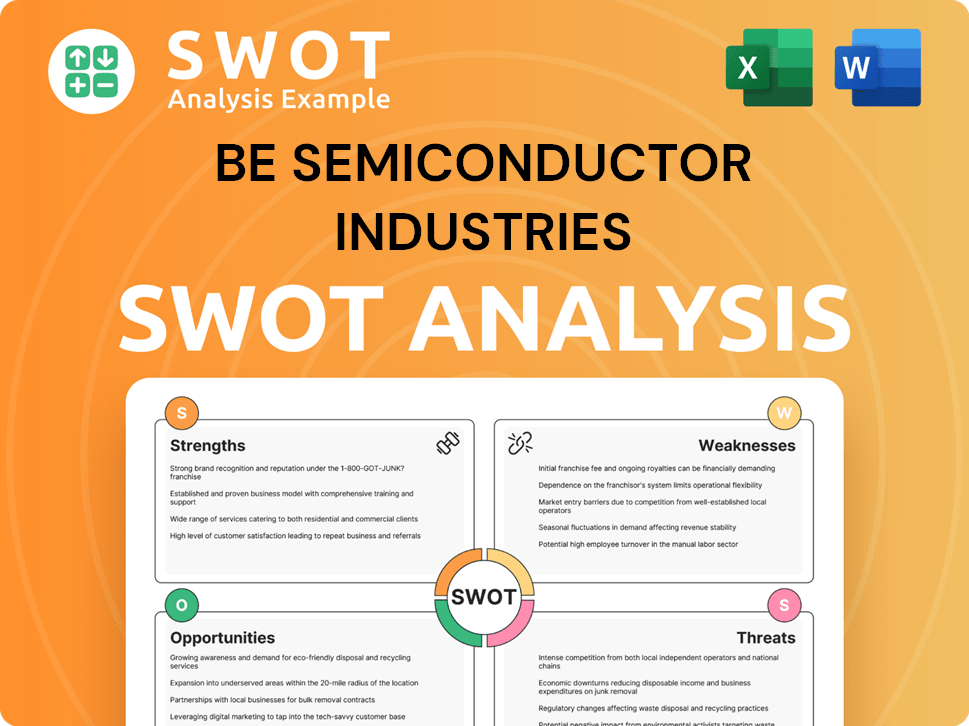
How Does BE Semiconductor Industries Invest in Innovation?
The growth trajectory of BE Semiconductor (Besi) is inextricably linked to its innovation and technology strategy. This strategy is centered around pioneering advanced semiconductor assembly solutions, which are crucial for the evolving needs of the semiconductor industry. Besi's commitment to technological advancement is evident in its substantial investments in research and development (R&D).
A key focus area for Besi is hybrid bonding technology. This technology is vital for next-generation semiconductor devices, especially in high-performance computing, artificial intelligence, and automotive applications. Besi's hybrid bonding solutions enable direct copper-to-copper connections between wafers or dies, leading to higher interconnect density and improved electrical performance. This innovation allows for smaller, more powerful, and energy-efficient electronic devices, aligning with the industry's demands.
Besi's innovation strategy extends beyond hybrid bonding to include advanced packaging solutions like fan-out wafer-level packaging (FOWLP) and system-in-package (SiP) technologies. These advancements contribute to the creation of smaller, more powerful, and energy-efficient electronic devices. The company is also dedicated to enhancing the automation and precision of its equipment, utilizing advanced robotics and vision systems to improve manufacturing efficiency and yield for its customers.
Besi's commitment to innovation is further demonstrated by its consistent efforts to optimize its product roadmap to align with the future needs of the semiconductor industry. This ensures its technologies remain at the forefront of the market, driving the Target Market of BE Semiconductor Industries. The company has secured significant orders for its hybrid bonding systems, with strong expectations for further growth in 2024 and beyond, indicating market validation of its innovative approach.
- R&D Investment: Besi consistently invests a significant portion of its revenue in R&D to maintain its technological leadership. Specific figures for 2024 are not yet available, but historical data shows a strong commitment.
- Hybrid Bonding Orders: Besi has reported substantial orders for its hybrid bonding systems, with expectations for continued growth in 2024 and beyond. This reflects the increasing demand for advanced packaging solutions.
- Market Trends: The semiconductor industry is experiencing rapid growth, driven by demand from high-performance computing, AI, and automotive sectors. Besi's focus on advanced packaging aligns well with these trends.
- Competitive Landscape: The competitive landscape in the semiconductor equipment market is intense, with several companies vying for market share. Besi's technological advancements and strategic initiatives position it favorably.
BE Semiconductor Industries PESTLE Analysis
- Covers All 6 PESTLE Categories
- No Research Needed – Save Hours of Work
- Built by Experts, Trusted by Consultants
- Instant Download, Ready to Use
- 100% Editable, Fully Customizable
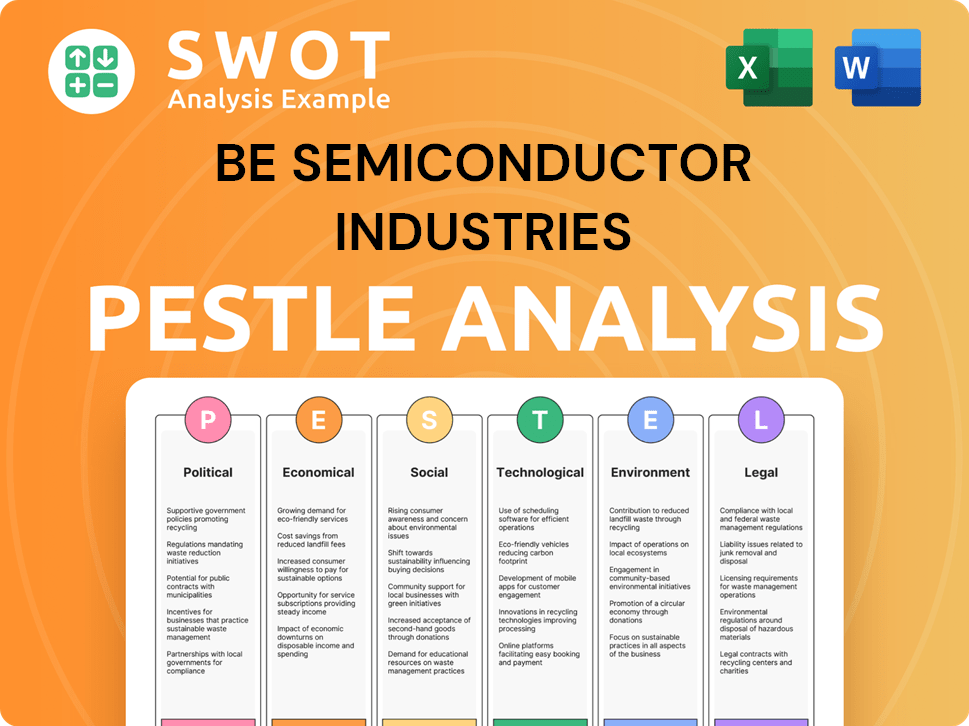
What Is BE Semiconductor Industries’s Growth Forecast?
The financial outlook for BE Semiconductor Industries (Besi) is promising, driven by strong demand for its advanced packaging equipment. Besi's focus on hybrid bonding is a key factor, particularly in high-performance computing and artificial intelligence applications. This strategic direction is expected to fuel significant revenue growth in the coming years.
For the first quarter of 2025, Besi anticipates revenue to be between €130 million and €150 million. This represents a substantial sequential increase of 15% to 35% from the fourth quarter of 2024. This positive forecast is supported by a growing order book for its hybrid bonding systems. The company's gross margin for Q1 2025 is projected to be between 46% and 48%, indicating healthy profitability.
Looking ahead, Besi expects a considerable increase in hybrid bonding revenue, projecting it to reach approximately €100 million in 2025, a significant rise from €30 million in 2024. The company's management has highlighted the substantial growth potential of the hybrid bonding market, which could become a multi-billion dollar market by 2028. Besi aims to capture a significant share of this expanding market. For more details, you can check out Revenue Streams & Business Model of BE Semiconductor Industries.
Besi's hybrid bonding revenue is expected to surge to approximately €100 million in 2025. This is a significant increase from the €30 million recorded in 2024. This growth is a key indicator of Besi's strategic success.
The total addressable market for hybrid bonding is expected to grow substantially. It has the potential to become a multi-billion dollar market by 2028. Besi is well-positioned to capitalize on this expansion.
Besi anticipates Q1 2025 revenue to be between €130 million and €150 million. The gross margin for Q1 2025 is expected to be between 46% and 48%. This indicates strong financial health.
Besi's strategic focus on advanced packaging and its leading position in hybrid bonding is expected to drive long-term growth. This focus is crucial in a challenging semiconductor equipment market. This is part of the company's Growth Strategy.
BE Semiconductor Industries Business Model Canvas
- Complete 9-Block Business Model Canvas
- Effortlessly Communicate Your Business Strategy
- Investor-Ready BMC Format
- 100% Editable and Customizable
- Clear and Structured Layout
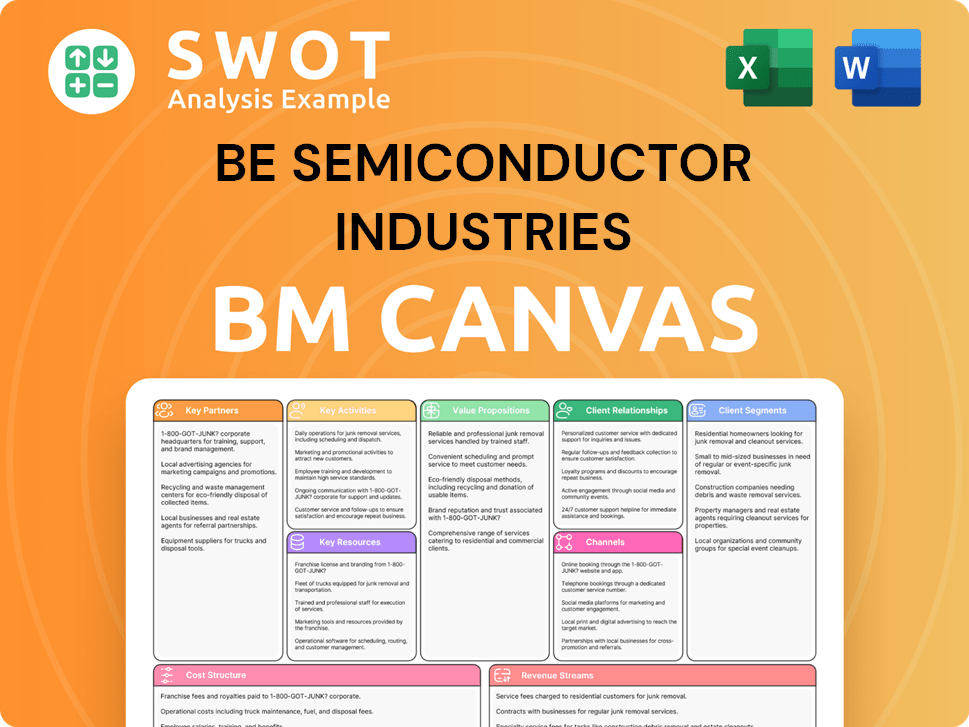
What Risks Could Slow BE Semiconductor Industries’s Growth?
The path of BE Semiconductor (Besi) towards its growth strategy is not without its hurdles. The semiconductor industry, where Besi operates, is inherently cyclical, meaning its performance is closely tied to global economic conditions and technological advancements. This creates inherent risks that Besi must navigate to maintain its future prospects.
Besi faces significant challenges from intense market competition within the semiconductor assembly equipment sector. Furthermore, supply chain vulnerabilities, technological disruptions, and regulatory changes pose additional obstacles. These factors can impact Besi's operations and financial outcomes, requiring proactive risk management strategies.
Understanding these potential risks is crucial for investors and stakeholders looking at the semiconductor company's long-term viability. It's essential to consider how Besi plans to address these challenges to sustain its growth trajectory and market position.
The semiconductor industry's cyclical nature presents a primary risk. Economic downturns can lead to reduced capital expenditure by Besi's customers, directly impacting its order intake and revenue. This makes it crucial for Besi to adapt to market fluctuations.
Besi faces continuous challenges from established and emerging competitors. This requires constant innovation and differentiation in its offerings. Staying ahead of the competition is vital for maintaining market share and achieving growth.
Besi relies on a global network of suppliers, making it susceptible to disruptions. Geopolitical events, natural disasters, or logistical challenges can lead to production delays and increased costs. Diversifying suppliers and robust risk management is key.
Rapid advancements in semiconductor manufacturing could render existing equipment obsolete. This necessitates continuous and substantial R&D investments. Besi must invest in the latest technologies to remain competitive.
Changes in international trade and export controls can impact Besi's global operations. This can affect its ability to access key markets. Besi must actively monitor and adapt to evolving regulations.
Besi mitigates these risks through diversified customer bases and robust risk management frameworks. Proactive engagement with supply chain partners is also crucial. These strategies aim to ensure resilience and sustained growth.
The semiconductor industry's volatility is influenced by factors like consumer demand and technological innovation. For instance, the growth of the AI sector is driving demand for advanced chips, but economic downturns can curb investment. Understanding market dynamics is crucial for Besi's strategic planning.
Besi's supply chain is global, making it vulnerable to disruptions. Recent events, like the COVID-19 pandemic, highlighted the need for diversified suppliers and robust contingency plans. Strengthening supply chain resilience is critical for maintaining production and meeting customer demands.
The rapid pace of technological change requires Besi to continuously innovate. Investments in R&D are essential to develop new equipment and stay ahead of competitors. Besi must anticipate and adapt to emerging trends in semiconductor manufacturing.
Besi's strategic initiatives include expanding its product portfolio and entering new markets. These efforts aim to diversify revenue streams and reduce reliance on specific customer segments. Successful execution of these initiatives is key to future prospects.
For more details on Besi's core values and mission, consider reading Mission, Vision & Core Values of BE Semiconductor Industries.
BE Semiconductor Industries Porter's Five Forces Analysis
- Covers All 5 Competitive Forces in Detail
- Structured for Consultants, Students, and Founders
- 100% Editable in Microsoft Word & Excel
- Instant Digital Download – Use Immediately
- Compatible with Mac & PC – Fully Unlocked
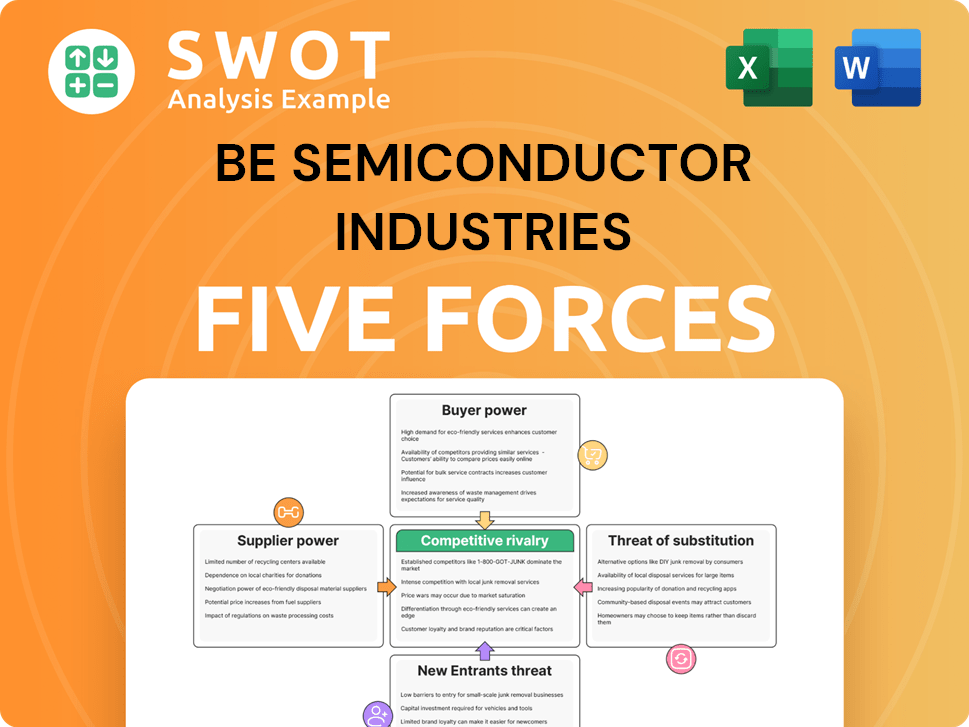
Related Blogs
- What are Mission Vision & Core Values of BE Semiconductor Industries Company?
- What is Competitive Landscape of BE Semiconductor Industries Company?
- How Does BE Semiconductor Industries Company Work?
- What is Sales and Marketing Strategy of BE Semiconductor Industries Company?
- What is Brief History of BE Semiconductor Industries Company?
- Who Owns BE Semiconductor Industries Company?
- What is Customer Demographics and Target Market of BE Semiconductor Industries Company?
Disclaimer
All information, articles, and product details provided on this website are for general informational and educational purposes only. We do not claim any ownership over, nor do we intend to infringe upon, any trademarks, copyrights, logos, brand names, or other intellectual property mentioned or depicted on this site. Such intellectual property remains the property of its respective owners, and any references here are made solely for identification or informational purposes, without implying any affiliation, endorsement, or partnership.
We make no representations or warranties, express or implied, regarding the accuracy, completeness, or suitability of any content or products presented. Nothing on this website should be construed as legal, tax, investment, financial, medical, or other professional advice. In addition, no part of this site—including articles or product references—constitutes a solicitation, recommendation, endorsement, advertisement, or offer to buy or sell any securities, franchises, or other financial instruments, particularly in jurisdictions where such activity would be unlawful.
All content is of a general nature and may not address the specific circumstances of any individual or entity. It is not a substitute for professional advice or services. Any actions you take based on the information provided here are strictly at your own risk. You accept full responsibility for any decisions or outcomes arising from your use of this website and agree to release us from any liability in connection with your use of, or reliance upon, the content or products found herein.